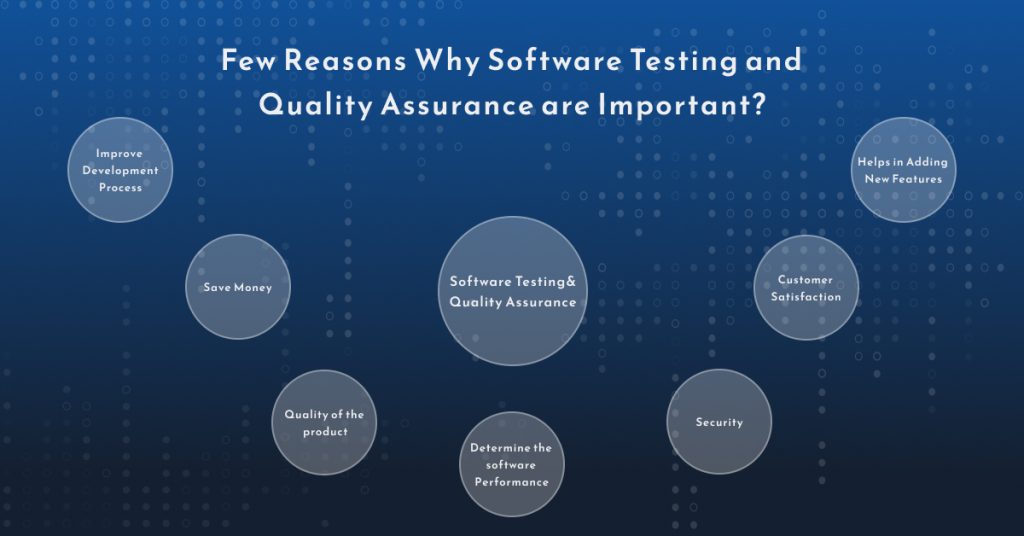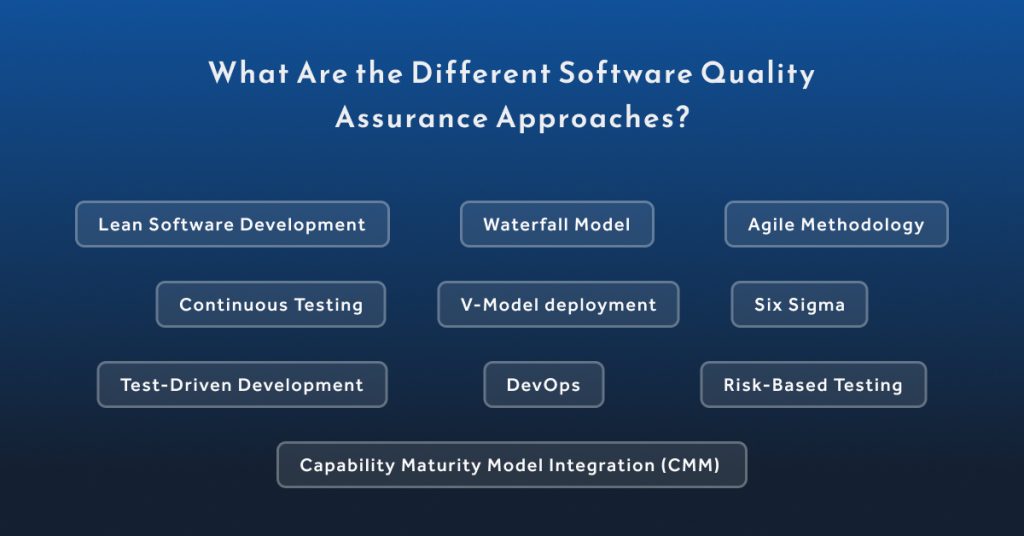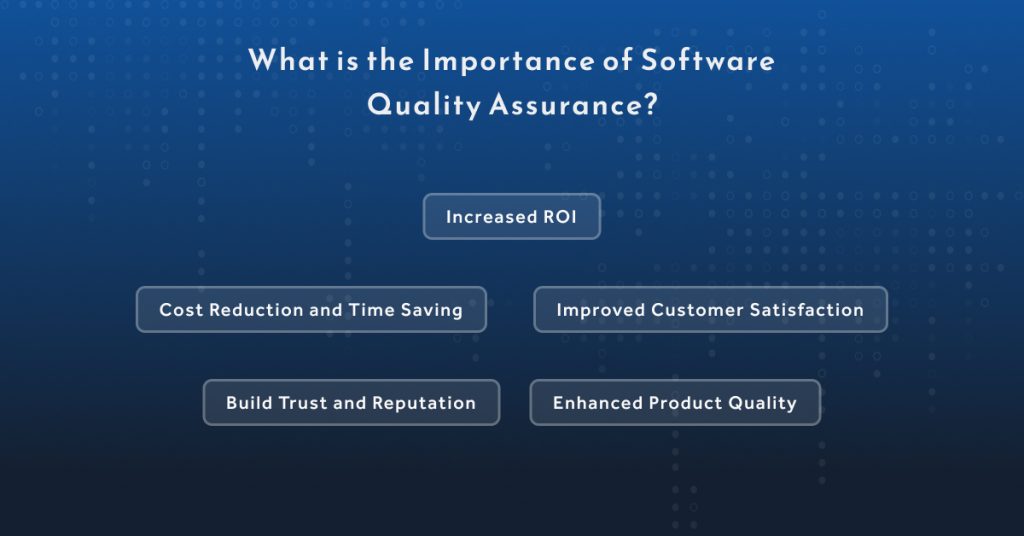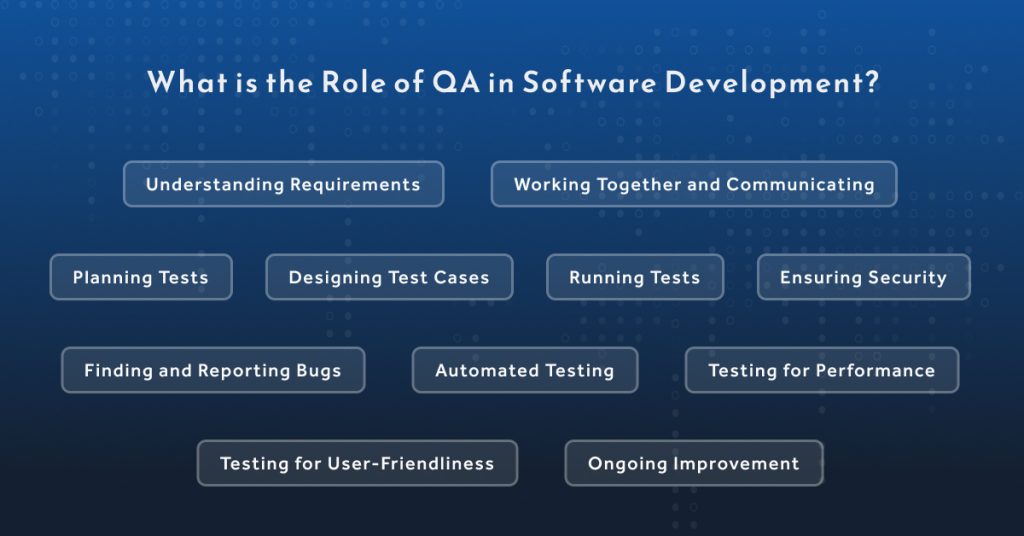In today’s digital world, software apps become an essential part of everyone’s life i.e. from banking to entertainment. Quality Assurance ensures the product or services meet or even surpass customer expectations. Here is a complete guide for you about all the necessary points of software testing services in 2024.
Whether in manufacturing, software development, healthcare or any other field maintaining quality is important. To make sure software applications work smoothly and meet user expectations, software testing and quality assurance (QA) are mandatory in software development. Software testing involves checking a product to detect bugs and make sure it meets the needed requirements.
Quality assurance goes a step further by focusing on preventing these bugs from occurring in the first place. Testing and QA are key to building successful software. Skipping testing and QA and jumping to another development process can lead to serious consequences that may include financial losses, unsatisfied users and reputational damage.
A software application with bugs and errors can lose the user’s trust and also slow down the business growth. That’s why quality assurance services are important for delivering a reliable and efficient custom software product. Testing and QA help ensure that the software performs well in different environments and situations. Quality assurance focuses on making sure the software meets set standards and guidelines that aim to prevent issues before they arise.
Outsourcing software testing services can be a smart pick for businesses without the resources for in-house QA.
In this blog, we’ll discuss why software quality assurance is important and the roles involved in testing and QA during custom software development.
What is Quality Assurance (QA)?
Quality Assurance (QA) is a structured procedure used by companies to ensure that products or services consistently meet specific quality standards. The main goal is to prevent errors, defects and inconsistencies to ensure the final product or service is of the highest quality. QA is a blend of procedures, tools and methods to monitor, assess and enhance the diverse parts of production or service delivery. It covers the entire software development process that is from gathering requirements to deploying the final product.
Key Elements of Quality Assurance are as follows:
- Process improvement
- Standard Adherence
- Risk Management
- Documentation
- Ongoing Improvement
Quality Assurance services should be on the top of your priority list as it helps enhance performance and create high-quality software for better user experience.
What are the Key Principles of Software Testing and Quality Assurance?



The 7 principles of Quality management are some key ideas that help companies achieve and maintain high-quality standards. These principles offer a framework for managing quality effectively.
Building Strong Relationships
Organizations gain from building strong relationships with their suppliers and partners. Working together collaboratively and maintaining effective communications helps create value and deliver high-quality products or services. Building a strong relationship with your software testing services provider is essential for avoiding issues and lack of communication.
Making Decisions Based on Facts
Decisions should be made by analyzing and evaluating data. Using evidence ensures that choices are based on facts and supports achieving organizational objectives.
Continuous Improvement
Continuous improvement is fundamental. Companies should regularly review the procedure, product, and system to find areas for enhancement and remove bugs.
Focusing on Processes
The organization should see its activities as connected processes. Managing these procedures is a systematic way to ensure efficiency, consistency, and the ability to meet the objectives or goals of the organization.
Involving and Engaging Users
Everyone in the organization plays a great role in achieving quality goals. Involving and empowering employees that offer training and fostering participation leads to better performance.
Effective Leadership
Strong leadership is also important for guiding the organization with a clear vision, setting goals, and creating a quality-focused culture.
Prioritising Customer Needs
Companies should recognize and meet the user’s needs while aiming to stand up to their expectations. Customer satisfaction is a key indicator of quality success. Software testing services ensure your application functions correctly and meets user needs before launch and avoids issues later.



Few Reasons Why Software Testing and Quality Assurance are Important?



Software Testing services are essential for various reasons:
Save Money
Software testing services offer lots of benefits to both client and company. However, cost-effectiveness is a major reason why companies invest in QA or software testing. Finding and fixing bugs early in the development process is more cost-effective than addressing them later. Testing often involves multiple phases and catching issues early helps save money.
Therefore, it’s essential to start testing as soon as possible. Hiring experienced quality analysts or testers who have the right technical skills is a smart investment that will benefit the project in the long run and ensure your software app works well.
Quality of the product
Security is another critical reason why software testing is crucial. Software is often a target for theft and misuse of personal information. This is why people seek out well-tested and reliable products.
When a product is thoroughly tested, users can be confident that it is trustworthy and prevent leakage of personal information. Testing helps ensure that the product is secure and free from vulnerabilities.
Security
Security is another critical reason why software testing is crucial. Software is often a target for theft and misuse of personal information. This is why people seek out well-tested and reliable products. When a product is thoroughly tested, users can be confident that it is trustworthy and that their personal information is protected. Testing helps ensure that the product is secure and free from vulnerabilities.
Customer Satisfaction
The main goal of any organisation is to ensure maximum customer satisfaction. Software testing is essential. Thus, it helps deliver a flawless user experience. Choosing to invest in thorough testing can help you build a reputation for reliability among clients. By focusing on testing, you can gain long-term benefits and earn the trust of your customers.
If your product has frequent glitches then It may damage your reputation and drive users to find alternatives. In today’s crowded market, making a good first impression is crucial. If your product doesn’t meet expectations then users are likely to look for other options that satisfy their requirements.
Improve Development Process
Quality Assurance helps identify various scenarios and errors that make it simpler to understand these issues and work on them. This allows developers to quickly fix them. Additionally, having a software tester work alongside the development team speeds up the development process.
Helps in Adding New Features
As the code becomes more complex and older then it gets harder to modify. Testing helps prevent these issues by letting the team safely add new features. The features are the centre of attraction that keeps the user engaged and maintains their interest. For new developers, updating old code can be intimidating but tests help ensure that essential functions aren’t broken. This makes your software more competitive and helps stand out in the market.
Determine the software Performance
If software or an application performs poorly, it can damage your reputation in the market and also disappoint the users. They may lose trust and also destroy the organization’s reputation. Experts in the industry agree that quality assurance services are essential. If you launch software without proper testing and it doesn’t meet user expectations. So, it will be hard to convince people to use it. Software testing helps ensure that the product performs well and meets client needs.
Note: – By investing in software testing services/quality assurance services, you can identify and fix bugs early that may lead to improving overall software performance.
Understanding the Quality Assurance in Software Development
Quality Assurance is a proactive procedure to make sure the software meets specific quality standards. Beyond just finding the bugs, the Quality Assurance tester focuses on improving the performance of software applications and fixing the issues. Quality Assurance activities are involved throughout the software development lifecycle including:
Reviewing and analyzing requirements
- Conducting design reviews
- Inspecting code
- Planning and designing tests
- Executing tests
- Tracking and resolving defects
- Auditing processes
Effective QA practices help companies create a quality environment that includes less development costs and also enhances user satisfaction.
What Are the Different Software Quality Assurance Approaches?



Several software quality assurance approaches, frameworks and methodologies that are especially created to make the software development processes smoother and ensure the products meet the user’s needs.
Waterfall Model
The waterfall model is a classic approach to software development which follows a sequential and linear process. Quality Assurance tasks are done at each stage before moving forward to the next. It’s cleared but less flexible to changes.
Agile Methodology
Agile follows the flexible and iterative approach that focuses on teamwork, adapting to changes and getting feedback from customers. In Agile, Quality Assurance is an essential part of the entire development process with ongoing testing and quality checks in each cycle.
DevOps
DevOps involves a way of working that focuses on better teamwork between development and operations teams. In DevOps, Software Quality Assurance (SQA) includes adding testing and quality checks into the continuous integration and deployment process to speed up and improve the reliability of software releases.
Lean Software Development
Lean principles focus on cutting out waste, boosting efficiency and offering value to customers. In lean, Quality Assurance aims to find and remove processes that don’t add to software quality.
V-Model deployment
The V-Model builds on the waterfall model by adding testing alongside each development step. In the V-Model, Quality Assurance activities match specific development stages so the testing is involved right from the start.
Continuous Testing
Continuous testing means testing software all through its development with automated tests built into the CI/CD process. This way, testing is conducted continuously which provides quick and regular feedback. The best software quality assurance (SQA) approach depends on things like project needs, the team set-up and the type of software involved. Many companies use a mix of these approaches to meet their specific needs.
Six Sigma
Six Sigma is a method that uses data to improve processes by reducing errors and inconsistencies. In software development quality assurance (SQA), six sigma helps measure and enhance the quality of software development.
Test-Driven Development
TDD is a method where you write tests before creating the code. In TDD, Quality Assurance ensures the testing is a key part of development. It supports incremental development and focuses on meeting specific goals.
Risk-Based Testing
Risk-based testing means focusing on testing software that are most likely to have issues. In this method, the Software Quality Assurance (SQA) team looks at and addresses the risk that could affect the software’s quality.
Capability Maturity Model Integration (CMM)
CMMI is a framework that helps improve software development and quality assurance processes. It outlines best practices and defines maturity levels. This allows organisations to evaluate their processes and find areas for improvement.
Key Differences Between QA Vs Testing
QA (Quality Assurance) and testing are different but work together in the software development process.
| Basis of Difference | Software Quality Assurance (SQA) | Quality Control | Testing |
| Goal | Making sure the development process is clear and followed | Ensuring the product meets quality standards | Confirming the software works correctly and meets requirements |
| Focus | Preventing defects by improving processes | Finding and fixing defects | Running tests to check if the software works |
| When needed | Throughout the entire development process | Throughout the entire development process | During the testing phase |
| Activities | Improving processes, following standards, training | Inspecting, reviewing and correcting issues | Planning, designing, running tests, reporting defects |
| Involvement | Involves all stages of development, including planning | Focuses on checking the final product | Mainly focused on the testing phase but planning starts earlier |
| Preventive or Corrective | aims to avoid defects by improving processes | aim to find and fix defects | Both preventive and corrective. Defects are found and fixed |
| Ownership | Shared by the whole development team | Usually the quality control team’s responsibility | Mainly the testing team’s responsibility |
| Metrics | Process efficiency, compliance | Defects, inspections | Test coverage, defect density, pass/fail rates |
| Outcome | Better development processes, fewer defects, higher quality products | Bugs identified and fixed, meeting quality standards | Bugs identified and fixed, meeting quality standards |
| Automation | May use process automation, not focused on test automation | May use automated tools for inspections | Focuses on automated test execution and regression testing |
| Examples | Coding standards and training programs | Code reviews, inspections | Unit testing, integration testing, system testing, acceptance testing |
What is the Importance of Software Quality Assurance?



Software quality assurance is a key element of the software development lifecycle (SDLC). It makes sure that the software product fulfil all quality standards and meets the client’s expectations.
Enhanced Product Quality
Software testing services ensure your software is bug-free, secure and enhances performance. Developers can offer a dependable, efficient and user-friendly product that meets both user expectations and industry standards.
Cost Reduction and Time Saving
By finding and fixing issues early in development, quality testing services avoid costly post-release fixes and save time. This proactive approach reduces wasted resources and makes the development process more efficient.
Improved Customer Satisfaction
Quality assurance services emphasise on usability testing to make sure the software is easy to use, runs smoothly and meets user needs. This results in a positive user experience, increasing user satisfaction and improving brand reputation.
Build Trust and Reputation
Launching software applications full of bugs can harm the company’s image and lose customer trust. QA reduces this risk by ensuring a polished and dependable product. This helps build customer’s trust and strengthen the brand’s reputation.
Increased ROI
Investing in Quality testing services help you get a better return on investment. It reduces expensive re-works, increases user experience and builds trust. This leads to more market share, revenue growth and long-term success.
What is the Role of QA in Software Development?



software testing services can be a strategic solution for businesses lacking internal resources for quality assurance. QA makes sure that both the software development procedure and the final product meet the required quality standards. Software Quality Assurance involves several activities throughout the software development procedures. They focus on preventing mistakes, finding and fixing early issues and ensuring the software meets or surpasses user expectations. Here, we are going to share a few important aspects of what SAQ does.
Understanding Requirements
SQA professionals get involved early in the software development process to understand and analyze project requirements. They collaborate and maintain transparent communication with stakeholders to clear up confusion and make sure the requirements are clear or can be tested.
Planning Tests
SQA also includes creating detailed test plans that explain the testing approach, goals, testing scopes, resources needed, timeline and when to start or stop testing. Test planning makes sure that testing is well-structured and matches the project’s objectives and organisation’s goals.
Designing Test Cases
QA engineers create test cases based on the software’s requirements and specifications. These test cases cover different scenarios to check the software’s functionality, performance and security. They act as a guide for carrying out tests.
Running Tests
Software testing professionals run test cases to check if the software works as expected and to find any bugs or problems. They perform various types of software testing like unit testing, integration testing, system testing and acceptance testing.
Finding and Reporting Bugs
Quality Assurance services partners use tools to track and monitor issues they find. They work with developers to fix issues to make sure the software will free from major bugs before it launches.
Automated Testing
Automation testing plays a crucial role in software quality assurance.It involves using automated tools to handle repetitive and time consuming testing tasks. This approach enhances efficiency, better coverage and maintains consistency throughout the testing process.
Testing for Performance
Software Quality Assurance (SQA) involves performance testing to evaluate the responsiveness, stability and speed of the software in the various situations. This helps ensure the software can manage expected workloads and functions well in real-life situations.
Ensuring Security
SQA professionals perform security testing to find any weak spots in the software. This is important to protect the software from possible threats and to keep data safe and user information private.
Testing for User-Friendliness
Usability testing checks how easy the software is to use and how well it works for users. SAQ makes sure the software is simple to understand and serves the needs of those who will use it.
Ongoing Improvement
Software Quality Assurance includes ongoing practices like retrospectives and post-release analysis. This helps spot areas where processes and methods can be improved. This leads to better overall software development quality.
Working Together and Communicating
Software Quality Assurance teams collaborate closely with software developers, product managers, scrum master, business analysts, and other key people to promote teamwork and ensure everyone is on the same page about quality goals. Transparent and good communication help resolve issues quickly.
Commonly Used SQA Tools
Software testing is important for maintaining software quality, saving time, effort and money and helping produce a top-notch final product. Developers can use various testing tools and platforms to automate and manage testing. Overall, this supports the goal of Software Quality Assurance (SQA).
Postman
Specially designed for web apps and APIs, this tool automates and runs tests. It works on Mac, Windows and Linux and supports Swagger and RAML formats making it a versatile option.
Jenkins
Another open-source tool is created to help developers and QA teams run and test code in real-time. Its automation features simplify the software building and testing process. This makes it ideal for a fast-moving development environment.
Selenium
An open-source software testing tool can run tests in popular programming languages such as C#, python and Java.



Challenges and Trends in Quality Assurance
Although quality assurance has improved a lot it still faces challenges and adapts to new trends. Automated tools and AI can speed up testing, improve accuracy and find problems quicker than manual methods.
Data Privacy and Security
As privacy concerns about data and cybersecurity grow, Quality Assurance practices need to include strong steps to protect the confidentiality, integrity, and availability of sensitive information.
Agile and DevOps
Using Agile and DevOps methods has transformed how we handle quality assurance (QA). Now, testing is included early in the development procedure helps developers release updates faster, keep integrating continuously, and quickly adjust new requirements.
Automation and AI
This is true that Automation and AI changed the QA procedure. Automated testing tools and AI algorithms can speed up testing, improve accuracy and find issues more quickly than manual methods.
loT and Industry 4.0
As the Internet of Things (IoT) and Industry 4.0 continue to grow, they bring new challenges and chances for quality assurance (QA). It’s important to ensure that interconnected devices and systems are both high quality and secure in these fast-changing tech environments.
Conclusion
To wrap up, choosing the right software quality assurance services partner is an essential part of the software development process. By focusing on testing and quality control, companies can make their products more reliable, lower costs and improve customer satisfaction. Having a strong AQA strategy is important in today’s competitive industry. Investing in quality assurance services helps businesses create a solid base for long-term success.
FAQs
Quality control is a part of the overall quality assurance process that ensures products meets the quality standards before it releases or makes live to users. By using quality control you can avoid delivering products full of bugs to customers and improve the supervision of employees’s work.
Choosing the right QA partner in this bust market can be a little tough but there are some key things you need to know.
Before starting, set clear quality standards with your selected quality assurance services provider. First a good QA partner will have a variety of care studies that show their work.
Focus on feedback that shows their experience and ability to meet the client’s requirements or goals.
You also need to notice if they show real interest in your project by asking questions about your objectives and target audience.
Also check out the company’s pricing and compare it to the industry average.
It’s important to consider and find their explanations clear as effective communication is key to successful partnership.
Outsourcing QA can be a smart choice for businesses that understand the need for software testing services but don’t have the resources to handle it in-house. To reduce security risks, it is important to perform background checks on potential outsourcing partnerships and draft detailed contacts that include confidentiality and data protection clauses. Before starting, it should be required to set quality standards with your WA partner and establish secure and efficient communication channels. This helps to meet quality standards and fulfil project’s needs.



Naveen Khanna is the CEO of eBizneeds, a company renowned for its bespoke web and mobile app development. By delivering high-end modern solutions all over the globe, Naveen takes pleasure in sharing his rich experiences and views on emerging technological trends. He has worked in many domains, from education, entertainment, banking, manufacturing, healthcare, and real estate, sharing rich experience in delivering innovative solutions.


